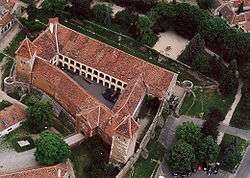Festetics Palace
The Festetics Palace is a Baroque palace located in the town of Keszthely, Zala, Hungary. The building now houses the Helikon Palace Museum.

The palace's construction, started by Kristóf Festetics in 1745, lasted more than a century. During this time, the palace, built at first on the foundations of a ruined castle, was tripled in size in two subsequent building campaigns, most recently in the 1880s, to designs by Viktor Rumpelmayer, living in Vienna.
When Rumpelmayer died in 1885, the work was carried to completion by architects Gusztáv Haas and Miksa Paschkisch.[1] The result is one of the three largest country houses in Hungary.
Early history
The Counts Festetics were progressive landowners: Kristóf Festetics founded a hospital, Pál Festetics established a school in the town, and in 1797, Count György Festetics opened an agricultural college, the Georgikon, the first of its kind in Europe, which is still in operation as a faculty of the University of Pannonia.
The palace's library wing was built by Count György Festetics in 1799—1801, with guidance from András Fischer of the Vienna Academy. Execution was entrusted to local artisans. The dining room (now a concert hall) has stucco decor by Mátyás Vathner from the town of Pápa. Stonework was executed by the local mason József Zitterbart, locksmithing by a local master craftsman, József Dobrolán, tiled stoves by József Pittermann and inlaid floors and woodwork by master carpenter János Kerbl, who was also responsible for the fittings in the library.
The book collection was made available to students of the Georgikon. The great book collection that remains in the castle is the only extensive aristocratic library that survives in Hungary.
The result is that the central axis of the garden front is centered on one pavilion of the corps de logis,[2] rather than on the prominent central tower of the extension built in the 1880s, with prominent mansard roofs and richly framed dormer windows typical of the neo-Baroque French Second Empire style, and neo-Renaissance woodwork in some of the interiors. On the entrance side facing the town, the axis remains centered on the original baroque structure, now a flanking wing.
The elaborate expansion was carried out for Count Tasziló Festetics,[3] who married Lady Mary Douglas-Hamilton (1850-1922) on 2 June 1880. He entertained Edward, Prince of Wales in October 1885 and again in 1888 during his "incognito" Hungarian visits, accompanied by his great friend the Duke of Hamilton, Festetics' brother-in-law.[4] Portraits of Festetics in tartans remain in the palace.
Recent history
Unlike the surrounding area, the palace was not damaged during World War II. The palace has housed an independent museum (Helikon Palace Museum) since 1974; it is visited by 200,000 people each year.
The parterres in which the palace stands were extended in the nineteenth century with a naturalistic landscape park in the English fashion. Open-air concerts are held on the grounds during the summer. The stable block now houses a collection of coaches and carriages.
Gallery
 Neo-Baroque garden gateway
Neo-Baroque garden gateway View of the garden
View of the garden- Interior of the palace
- View of the library
Notes
- The neo-Renaissance Festetics Palace in Budapest was designed by the prominent Hungarian architect Miklós Ybl: "A Presentation of the Festetics Palace" (click on icon for English text.)
- Designed by Kristof Hofstadter, 1755.
- created Fürst Festetics von Tolna in 1911.
- "Géza Buzinkay, "The Prince of Wales Incognito"". Archived from the original on 2008-06-04. Retrieved 2008-01-12.
External links

- Helikon Palace Museum - official website
- Palace info on the Keszthely town website
